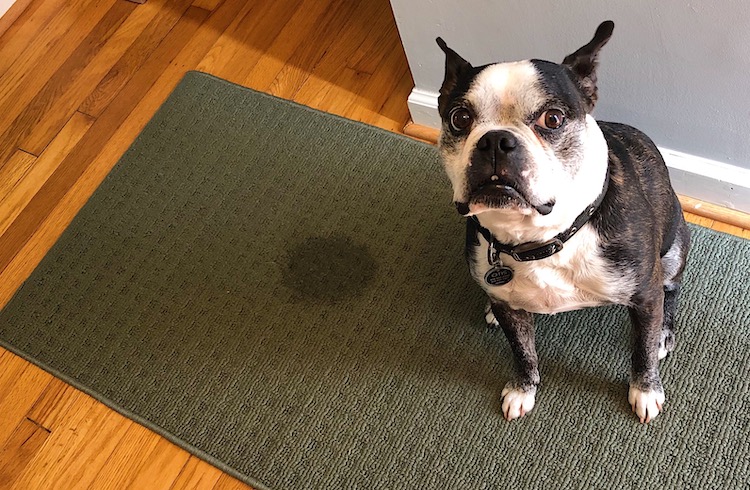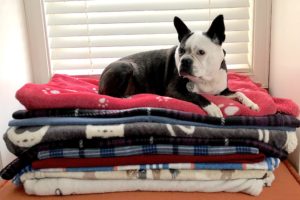So, your foster dog is not house-trained and doesn’t get it. You want it to potty outside. You’ve tried everything, and your foster dog is still having potty accidents.
“House-Training Is Haaaarrrrrd!”
No it isn’t.
It’s inconvenient, but is not hard. It is frustrating to have a dog that is not house-trained. None of us like to clean up accidents. None of us want pee smells in our home.
I’ve had a dog squat and pee on my nice hand-knotted wool rug. More than once. I once had a dog to pee on my sofa. That was a very bad day! When a foster dog is not house-trained, it can cause problems.
House-training is hard when you don’t follow a house-training protocol!
The other day I received a written message from a rescue friend who recently adopted a young puppy. Frustrated, fed up with pee accidents everywhere, she’d all but given up on ever training her puppy to potty outside. I gave her words of encouragement. “You can do this!” I replied and reminded her of a house-training protocol available to her.
When your foster dog is not house-trained and doesn’t seem to be learning how to potty outside, we can take a look at some reasons why:
1. There is a medical reason your dog won’t house-train.
My first rescue mentor drilled this into my head, and it is so so true! She said, “Always rule out medical issues for behavioral problems.”
She is right. Sometimes, there is a medical reason a dog will not house-train, is having accidents inside or just-can’t-get-the-hang-of going potty outside.
Urinary tract infections are a number one reason a dog has pee accidents inside. Or
2. Overusing belly bands, diapers, and pee-pads slows down the house-training process.
Belly bands, diapers, and pee-pads certainly have their place in rescue work. I have them all in my supply cabinet and I do use them.
I do not use them to help a foster dog house-train.
Belly bands were invented not as a tool to help you keep your house clean while you house-train, but they were invented to catch urine from a male dog with bad marking behavior.
Marking behavior and failure to house-train are two totally different things. Using belly bands for a dog not house-trained is lazy. Using a belly band because you have a male dog that marks is perfectly fine. Just don’t rely on the belly band to solve the house-training and marking behaviors. It won’t. If you need to use the belly band, do so while adhering to a strict house-training protocol and you’ll have quick success.
I do use belly bands in conjunction with confinement if I have a male dog that is in the habit of peeing in his crate. It’s important to keep the crate as pee-free as possible.
I’ve used diapers with female dogs with separation issues who pee in the house when I leave them alone. Emmy Lou wore diapers every time I left home. I couldn’t crate her, and I needed to contain the daily peeing.
I usually only use pee pads with puppies in their x-pens or maybe at the one door we use to go out to potty outside or when I have to quarantine a sick dog. I’m sure there was a time or two when I’ve had to use pee pads for a different situation, such as a senior dog who has lived her life using pee pads. That said, as a rule, if I’m house-training a healthy adult dog, I do not use them.
3. Dogs with too much freedom in the house will potty inside
You may have found a little pile of poo in the upstairs guest room. Or a tee-tee spot in the utility room. You might wonder why the dog chose to relieve itself there instead of by the door or in the rooms where everyone normally hangs out.
Did the dog choose a hiding place to go to the bathroom knowing it is wrong? No, not necessarily. I will say, as do the experts, that if you give your dog a lot of grief for pottying inside, they may try and find a new spot that will make you happier! “Ah – no one is ever in here, I’ll go here.”
Truth? In general, dogs want to keep their “house” clean. In the wild, this means the place they come home to rest.
When we bring dogs inside, the definition of “house” is blurry and we have to help them learn the difference between inside and outside. This is never more true when we are fostering a dog rescued from a puppy mill or dog hoarder. These dogs have had no choice but to live with their excrement. They do learn how to potty outside, using the same protocols.
Confinement works!
Decide right now that you want no more potty accidents inside. You are going to grab this problem (not the dog!) by the horns and do what you have to do.
Get a crate.
Or an x-pen.
Or a baby gate.
If you don’t want to confine when your dog is not house-trained, you’ll need to tether them to you so they stay close to you and you are immediately available to see their pre-potty behaviors, interrupt a squat, and get them outside to potty.
In my opinion, confinement is easier.
Select a small space for your dog to live when you are not actively supervising. And I do mean small.
I’ve used a section of my kitchen that I baby-gated off. Some of my rescue peers use a spare bathroom. I most often use my office space and set up a crate or an x-pen in this room. My office is about 9 x 10 (it’s my former dining room) so it’s a bit too much space on its own to use for house-training.
If I have a young puppy, I’m almost always going to use a crate at first. When I advance to an x-pen, I will put a bed (or crate) in the x-pen and a couple of toys, plus a water bowl to identify the feed area. I’m in essence setting up a tiny house for the dog!
While there’s a little bit of floor space for a dog to go to the bathroom, the idea is that it’s too close to the bed or the food/water. The dog should “hold it” for a little bit.
Your next job after you’ve set up this tiny house is to keep to a strict potty schedule. Be fair. You’ve restricted their movement and taken away a lot of free space. Give them regular and frequent opportunities to go potty where you want them to, or they will have no choice.
4. The dog is showing you pre-potty behaviors and you don’t recognize it.
Every dog has pre-potty rituals. Even when a dog is not house-trained. It’s your job to figure out the unique ritual for every foster dog that comes into your home.
Some dogs have a long ritual. Some dogs have a ritual that may last a nano-second. That last part is a bit dramatic, but really – some dogs only show very little pre-potty behaviors, but they do have a ritual.
This ritual is what you must recognize if you want to catch your dog before they squat indoors.
It is also the ritual you want to know if you want to teach your dog to poop on cue.
Many dogs will sniff the floor or ground. Some dogs pace. Some walk in a circle.
Leave your cell phone indoors.
Rapid success with house-training means you must keep your eyes on the dog. So, when you are outside for the 15th time of the day, your eyes still need to be on the dog, not your screen.
- Pay attention to the pre-potty behaviors.
- Pay attention to when the dog actually does potty outside so you can immediately praise them for a good job.
- Pay attention to if your dog is distracted and not focused on going potty outside so that you can adhere to the house-training protocol and bring the dog back inside, confine, and try again in a few minutes.
In short, house-training means you have to, HAVE TO be engaged with your dog.
Your text messages can wait.
5. Missed scheduled outdoor potty breaks are a sure way to get an accident inside
Follow the schedule.
The schedule looks brutal, I know – I use it! But it works.
Adult dogs go back to kindergarten
I highly recommend that if you are house-training an adult dog that you take them all the way back to puppy house-training. That means giving them the opportunity to go potty outside every one-and-a-half to two hours.
You may only need to do this for a couple of days. If your adult dog has had zero inside accidents for 48 hours, you can gently add more time in between potty breaks. I suggest 30 minutes, definitely no more than an hour. If your dog has an accident, you added too much time, too fast.
6. There’s more “Uh-oh” shaming happening and not enough “Good job!” praise
Dogs do not make pottying mistakes.
If your foster dog is not house-trianed, it goes inside because it hasn’t been taught to hold it. It hasn’t been taught that you want it to let you know it needs to potty. It goes inside because it just can’t hold it any longer.
Their potty accident is your mistake, not theirs.
So, do not shame your dog. Don’t say, “uh-oh.” “Bad dog” or any other phrase that has tone.
My mother used to put her hands on her hips and look at the dog and say, “ah-woo-woo! look what you diiiiiiiiiiid.” The dog stared back at her, clueless.
If you find an accident, don’t talk to the dog about it. Clean it up with a good product and identify what went wrong with your protocol/schedule and adjust.
Do interrupt
Early on in the house-training process, you may see your foster dog doing those pre-ritual behaviors or you may actually see your dog start to squat or hike that leg.
This is the time to interrupt to stop the dog.
I use the word, “ah” instead of the word “no.” To me, the word comes out faster and with more authority than saying no. I feel like I sound like I’m yelling when I say “no” with firmness. And I don’t want my foster dog to think I’m yelling at it.
Follow up the interruption with a directive such as “outside!” or if the dog is small enough I am early in the house-training process, I’ll carry or lead the dog outside.
Do praise
You will get your dog house-trained faster when you praise them every.single.time they tee-tee outside. Use your squeaky voice, say “yay, yippee, good job!” over and over and pet them, invite them for a very quick game of tug or fetch or you can even give them a treat.
Your dog wants to please. Your dog is motivated by what is rewarding. If you want your dog to potty outside, you have to reward them every time they do.
Bottom line:
- accidents = silence
- catching in the act = use the interrupt word
- successful potty outside = praise, petting, games, treats.
My dog, Otis is 7 years old. I open the door, he takes himself out to potty, comes back to the door, I let him in and still frequently tell him, “good job.” He’s been house-trained for years, and I still let him know I appreciate it.
7. The expectations of the dog are super high.
Please. When your foster dog is not house-trained at all, take your expectations down to zero.
Expectation is not the same thing as belief. I believe my dog can become house-trained. I don’t expect them to get it right. I don’t expect them to learn on the first try. I don’t expect them to never, ever have an accident.
We put a lot of pressure on dogs, foster dogs included. When we feel frustrated toward our dogs, it’s usually because we’ve expected too much from them.
8. The expectations you place on yourself are too low
A little louder for the people in the back!
We have more expectations on our dog than we do on ourselves.
I think we ignore the advice given by veterinarians, dog trainers, breeders, and seasoned rescue experts:
- follow an interval schedule.
- decrease potty accidents inside
- increase successful potting outside
- reward, reward, reward
I think we don’t commit to the process.
I assure you, if you commit to the process, raise the bar on yourself, live with some inconvenience, interruption, distraction, you will get your foster dog house-trained.
I’ve written a blog post on a house-training protocol for dogs that I use and you are welcome to use it, too.
How To Housetrain – A Plan That Works
Mine isn’t the only protocol out there. You can choose from one of several house-training protocols on the internet. Pick a plan that includes a structured timeline. I promise, it will help you!
remember:
- Increase successful pottying outside
- Decrease incidents of indoor accidents.
Good luck! I wish nothing but goodness towards you as you embrace this journey with a foster dog that is not house-trained. I’m sure some of you have trained some challenging dogs to eventually potty outside. I’d love to hear your stories! Do you have a foster dog that is particularly challenging to house-train? Tell me about it, maybe we can figure it out together.
Additional Resources
Popular Posts
- HOW TO CHOOSE A DOG RESCUE AGENCY
- ULTIMATE GUIDE TO FOSTERING: 10 SKILLS YOU NEED
- VOLUNTEER IF YOU CANNOT FOSTER




